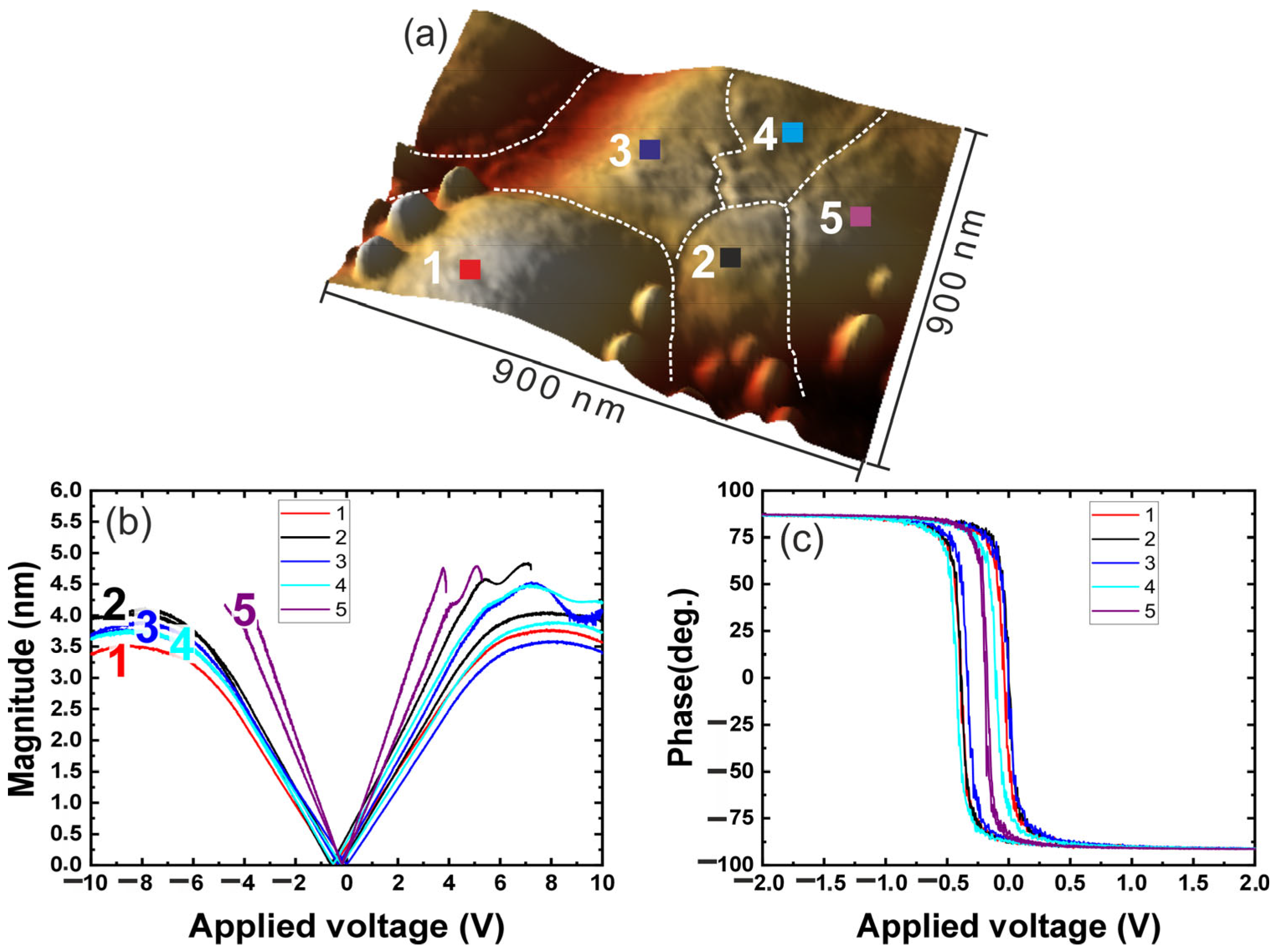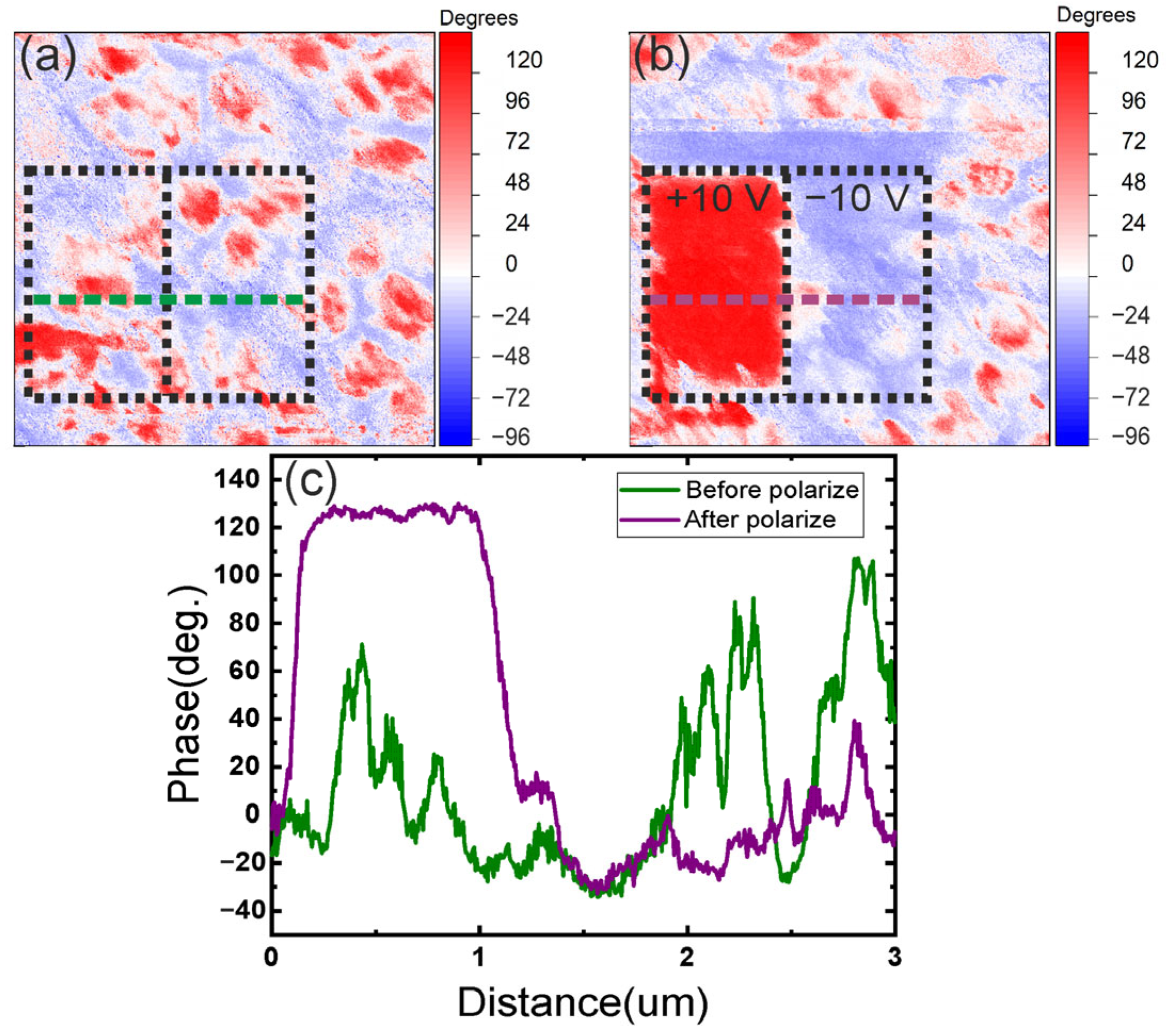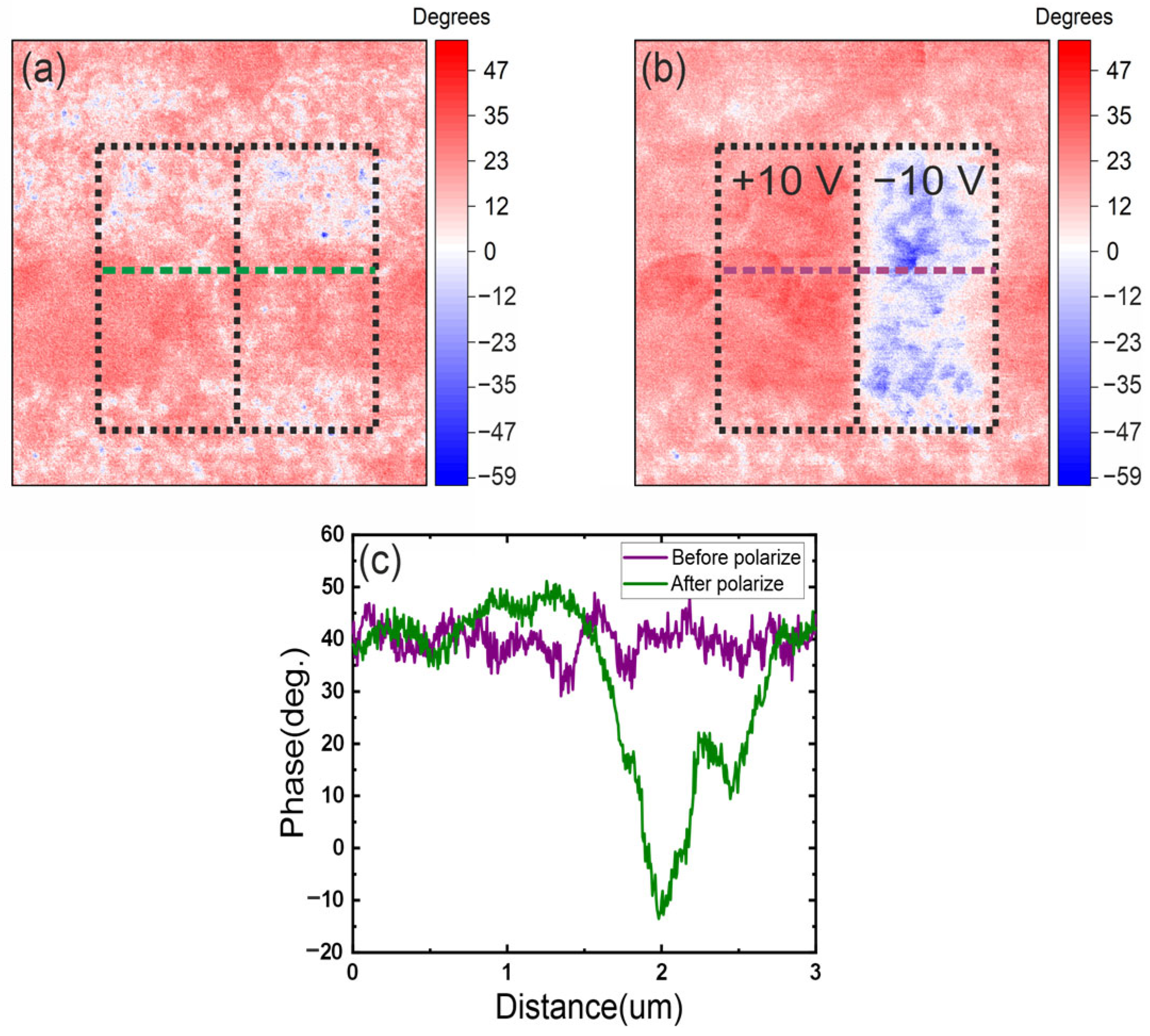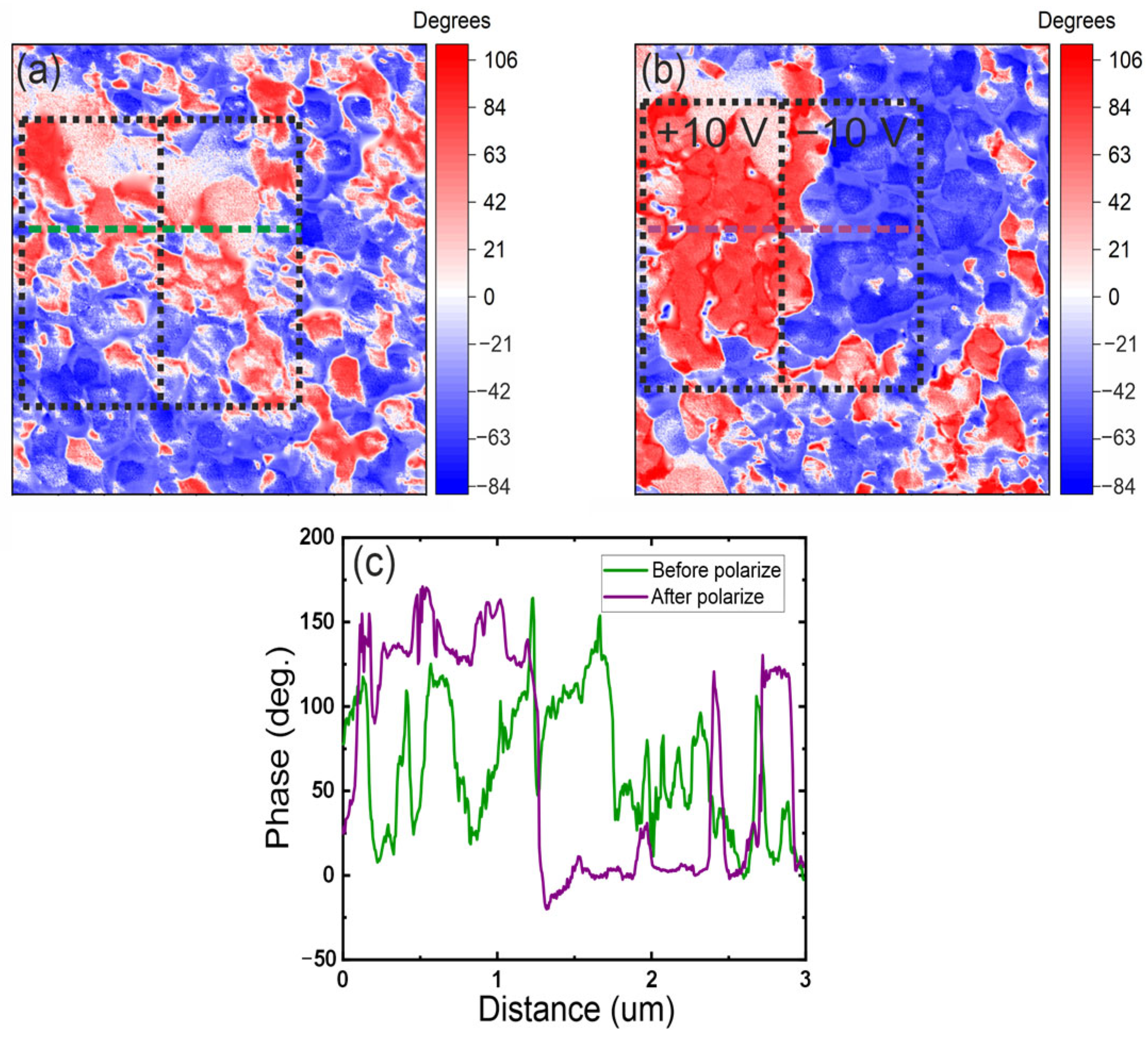3.1. Analysis with an X-Ray Diffractometer
To confirm the crystallinity of the PZT films, diffractograms were obtained for samples with 3% and 14% PVP content (
Figure 1). The diffractograms of the rest of the series were presented in [
32]. A DRON-8T diffractometer in a non-monochromator configuration at 40 kV and 20 mA current on an X-ray tube was used to obtain the diffractograms. The tube has a Soller slit and a 0.5 mm wide equatorial slit. A Soller slit, a 0.25 mm wide equatorial slit, and a nickel beta filter were used on the detector. The scanning was carried out using a discrete method with a step of 0.02 degrees; the signal accumulation time for one point was 15 s.
The diffractogram of the sample with 3% PVP addition (
Figure 1, red line) shows peaks corresponding to the PZT phase located at angles 22°, 31°, 45°, 55.5°, which are identified with orientations (100), (110), (200), (210). The sample is polycrystalline. In addition, the diffractogram shows peaks related to the phases of Pt, Si. The diffractogram of the sample with 14% PVP addition (
Figure 1, black line) also demonstrates Pt and Si peaks. However, the peaks corresponding to PZT have almost completely disappeared, with only weakly pronounced (100) and (110) crystallographic reflections remaining. The obtained results demonstrate good agreement with previous findings reported in [
33], where X-ray diffraction analysis was employed to investigate residual stresses in PZT thin films fabricated via pulsed laser deposition. This consistency provides strong evidence that the studied samples maintain a perovskite phase structure.
3.2. Analysis of Local Surface Morphology Using SEM
The utilized configuration of SEM allowed for the obtaining of detailed high-resolution images of the surface morphology of the samples (
Figure 2).
The sample with 0% PVP content (
Figure 2a) displays a relatively smooth, continuous surface with minimal texture and few distinguishable features. The surface appears largely homogeneous with some subtle grain boundaries or minor irregularities visible across the field of view. In contrast, the introduction of just 1% PVP (
Figure 2b) induces a dramatic structural change, with the emergence of numerous small pores distributed across the surface. These pores appear relatively uniform in size and demonstrate consistent spacing throughout the material. At 3% PVP content (
Figure 2c), the evolution of surface morphology continues with a notable increase in both pore size and density. The pores appear larger, more defined, and potentially deeper compared to those observed in the 1% PVP sample. The spaces between pores have become thinner, suggesting a progressive transformation toward a more interconnected porous network.
A fundamental shift in morphology occurs at 6.6% PVP content (
Figure 2d), where the structure no longer resembles a continuous matrix with pores but instead appears as an assembly of discrete particles. These particles create a highly porous, interconnected network with significant void space between the individual elements. The particles appear somewhat irregular in size and arrangement, creating a complex three-dimensional structure. The sample with the highest PVP content of 14% (
Figure 2e) maintains the particulate nature observed at 6.6% but exhibits notable refinement. The particles appear more uniform in size, more spherical, and demonstrate a more ordered arrangement with denser packing.
The progression from 0% to 14% PVP content reveals several key trends in material structure. First, there is a clear increase in overall porosity and surface area with increasing PVP concentration. The initial formation of isolated pores eventually gives way to a highly porous network and finally to a particulate structure with interstitial spaces. The transition from a porous continuous matrix to a particulate structure represents a fundamental change in material architecture. This suggests that PVP may be functioning not only as a porogen (pore-forming agent) at lower concentrations but potentially as a structure-directing agent or particle growth modifier at higher concentrations. Additionally, the increasing uniformity and ordered arrangement of particles at the highest PVP concentration indicate that PVP may influence nucleation and growth mechanisms, potentially by controlling aggregation processes or surface energetics.
3.3. Analysis of Local Surface Morphology Using AFM
The analysis of PZT film topography with varying polyvinylpyrrolidone (PVP) concentrations revealed significant structural transformations depending on the porogen content (
Figure 3).
The 0% PVP sample exhibited a granular surface morphology with a maximum grain height of 18 nm and an average grain boundary width of 15 nm. Porogen particles, highlighted in
Table 2, ranged from 10 to 20 nm. With the addition of 1% PVP, the maximum surface height decreased to 15 nm, while the grain boundary width increased to 35 nm. Porogen particles remained present, with some reaching heights of up to 40 nm. Additionally, the formation of surface pores was observed, with an average depth of 20 nm and widths varying between 50 and 100 nm. At 3% PVP, the average grain boundary width increased to 40 nm, with a higher concentration of pores compared to the 1% PVP sample. With 6.6% PVP, the grain boundaries were almost entirely disrupted, leading to the formation of larger grains with heights ranging from 60 to 100 nm and widths reaching approximately 300 nm. Finally, at 14% PVP, the film exhibited a fine-grained structure, where grain boundaries were destroyed. The characteristic grain sizes varied from 30 to 70 nm in height and 100 to 300 nm in width. These findings indicate that an increasing PVP concentration leads to progressive microstructural changes, transitioning from a well-defined granular morphology to a more porous and fine-grained structure.
A quantitative assessment of the average topography values was then performed based on three key criteria: average roughness, root mean square (RMS) roughness, and the area occupied by pores. The average roughness (Sa) represents the arithmetic mean deviation of the surface profile, while the RMS roughness (Sq) reflects the root mean square deviation of surface heights from the mean plane. To calculate the air-phase area (As) within the analyzed sample region, the average height level of the topography was first determined. Then, all areas below this level were identified, and their total surface area was measured. The results of the structural topography analysis are summarized in
Table 2.
The data analysis reveals distinct trends in surface roughness and porosity as a function of PVP concentration. The average roughness (Sa) for the 0% PVP sample is 5.28 nm. With an increase in PVP concentration to 1%, Sa decreases to 4.25 nm. However, at 3% PVP, the roughness significantly rises to 10.31 nm. Further increasing the PVP concentration to 6.6% and 14% results in even higher roughness values of 16.38 nm and 16.03 nm, respectively. The root mean square roughness (Sq) follows a similar trend. For the 0% PVP sample, Sq is 6.56 nm, decreasing to 5.55 nm at 1% PVP. However, with 3% PVP, Sq sharply increases to 13.49 nm. At 6.6% and 14% PVP, it reaches its highest values of 20.10 nm and 20.05 nm, respectively. The air-phase area (As) also exhibits significant changes with increasing PVP concentration. In the 0% PVP sample, As is minimal and close to the sensitivity threshold of the instrument. When the PVP concentration is increased to 1%, As expands to 0.506 μm2. In the 3% PVP sample, it grows further to 1.624 μm2. For 6.6% and 14% PVP, As reaches 2.619 μm2 and 1.637 μm2, respectively. These results clearly demonstrate how PVP concentration influences the surface topography of films. As the polymer content increases, both average and RMS roughness rise, alongside a significant expansion in pore-covered surface area. This is due to the fact that the surface of PZT films undergoes the transition from a non-porous, smooth film to a highly porous and rough film. This indicates the formation of a more porous and irregular structure, which directly affects the functional properties of the material.
In Park et al. [
34] and Choi et al. [
24], PZN–PZT films with a 60/40 composition were fabricated via sol–gel processes using PVP and 1,3-propanediol as additives. In both studies, an optimal Pb/diol ratio of 1:10 and a controlled pyrolysis temperature of 250 °C were employed. This approach yielded dense, crack-free films with a thickness of approximately 1 μm and a strong (100) preferred orientation (around 90%). SEM analysis in these works revealed that the optimized films possess a smooth surface with large rosette-like grains and a columnar cross-sectional structure containing only very small nanosized pores (≈5% by volume). Ferroelectric measurements (P–E hysteresis loops) and the evaluation of the effective d
33 coefficient (≈70 pC/N) confirmed that these films exhibit excellent ferroelectric and piezoelectric properties—comparable to or even slightly exceeding those of films prepared by conventional multilayer sol–gel methods. In Rodríguez-Aranda et al. [
35], PZT films fabricated by the sol–gel acetic acid route also display a relatively uniform surface morphology. SEM and AFM studies show grain clusters with a characteristic size of approximately 400 nm and very low surface roughness (1.2–1.6 nm), reflecting excellent film densification and optimal grain growth achieved through efficient nucleation and crystallization. In contrast, our samples—with increased porosity achieved by higher PVP concentrations—exhibit a more inhomogeneous and fragmented domain structure, accompanied by higher surface roughness and larger pore areas. These microstructural modifications can adversely affect the uniformity of the piezoelectric response. Moreover, the dense, columnar films reported by Nguyen et al. [
36] demonstrate a stable, preferentially oriented domain structure that ensures a more uniform distribution of electrical properties and superior performance.
3.4. Analysis of Local Piezoelectric Hysteresis Loops Using PFM
To perform PFM measurements, samples with 0%, 6.6%, and 14% PVP were selected. The 0% PVP sample was chosen as the most densely packed structure, as it was expected to exhibit the most uniform response. In contrast, the 6.6% and 14% PVP samples, due to their unique pore distribution, were anticipated to demonstrate distinct local properties compared to dense structures with the same chemical composition [
32]. The PFM method was also being employed to obtain and analyze the distribution of the local piezoelectric hysteresis loops on the samples’ surfaces. During scanning, two signals were recorded: cantilever deflection from its initial position, which characterized piezoelectric deformation in response to the applied field (the magnitude of PFM signal), and the shift in cantilever vibration frequency relative to the lock-in detector frequency, indicating the direction of deformation (the phase of PFM signal). The phase signal was used to determine polarization, as in ferroelectric structures, there is a direct linear correlation between piezoelectric deformation and polarization. This method provided insight into the local piezoelectric properties of the samples and how they are influenced by the presence of porosity and structural heterogeneity.
Figure 4 presents the local piezoelectric hysteresis loops for the 0% PVP sample.
Figure 4a illustrates the scanned area, where different colors indicate contact regions between the probe and the surface of the structure. To ensure experimental accuracy, various grains were selected, with their boundaries marked by white dashed lines.
Figure 4b,c depict the piezoelectric deformation (magnitude) response and phase switching as functions of the applied electric field, respectively. While the signal measured in magnitude of hysteresis loops is driven by the thin film-associated electromechanical response, the phase represents the switching behavior of the film. The colors of the curves correspond to the colored squares in the topography image. The results indicate that the dense 0% PVP sample exhibits piezoelectric responses that are consistent within the measurement uncertainty, suggesting that the material properties remain uniform across different grains. This confirms the expected homogeneity of the dense structure, where the absence of pores minimizes local variations in electromechanical behavior.
In
Figure 5a, the surface is composed of multiple grains, indicating a significant structural transformation compared to the dense 0% PVP sample. These changes in microstructure also introduce distortions in the piezoelectric response dependencies, as observed in
Figure 5b,c. Notably, the phase signal hysteresis loop at Point 1 (red line) exhibits a directional change compared to other measurements on this sample, suggesting local variations in ferroelectric behavior. Furthermore, the cantilever deflection due to piezoelectric deformation at Point 1 reaches 3 nm, the highest recorded value, whereas in other cases, the deflection remains below 1 nm.
The surface of the 14% PVP sample consists of distinct, well-defined grains, as shown in
Figure 6a. The local piezoelectric hysteresis loops results indicate that the deformation response at Points 1–3 is comparable to that of the dense 0% PVP sample, although slightly lower in magnitude. In contrast, the responses at Points 4 and 5 are more similar to those observed in the 6% PVP sample, as shown in
Figure 6b. The polarization hysteresis loops exhibit a similar trend across different measurement points, except for Point 5, where an anomalous response is detected. The change in the loop shape at this location is associated with a low piezoelectric deformation response, below 0.5 nm, which is also observed at Points 4 and 5. However, the mirrored loop reversal, previously identified in the 6% PVP sample, is only present at Point 5 in this case, as shown in
Figure 6c. These results suggest that at higher PVP concentrations, the material develops localized electromechanical variations, where some regions retain characteristics of a denser structure, while others behave similarly to more porous configurations.
Changes in the magnitude and direction of the polarization hysteresis loops under the applied field were observed exclusively in the 6.6% and 14% PVP samples. The piezoelectric deformation loops of the dense material showed significant differences compared to Points 2–5 in the 6.6% PVP sample and Point 5 in the 14% PVP sample. However, certain cases exhibited no loop reversal (e.g., Point 4 in the 14% PVP sample), yet a more than tenfold reduction in the piezoelectric deformation signal was still observed. These results suggest that at higher PVP concentrations, the structural modifications—particularly the redistribution of charge transport pathways and grain boundary effects—strongly influence the local electromechanical response.
3.5. Analysis of Spontaneous Polarization Distribution Using PFM
The mapping of spontaneous polarization distribution was performed by applying an alternating electric field to the probe. This study focused on probing the z-component of the signal, meaning only the normal polarization distribution relative to the surface was recorded (out-of-plane PFM). In
Figure 7,
Figure 8,
Figure 9,
Figure 10 and
Figure 11a,b, the red and blue regions represent two opposite polarization states in the examined ferroelectric films. The blue color indicates a displacement directed outward from the surface, while the red color corresponds to a displacement directed into the film. The white areas in the images represent regions where the beam oscillation phase matches the frequency of the detector oscillations, suggesting minimal or no local polarization contrast.
The predominance of the blue color in the initial polarization state, observed before the polarization process, indicates that negatively polarized domains dominate over positively polarized ones. To modify the polarization distribution profiles, charge lithography was employed. During this process, voltages of opposite polarity were applied to the left and right sides of the mask. As a result, within the masked area, a red region was induced by the application of a positive voltage, while a blue region emerged due to the application of a negative voltage. This demonstrates the reversibility of polar states under the influence of an external electric field. The external areas in the images represent the initial piezoresponse of the films before polarization modification, highlighting the contrast between the pristine and electrically manipulated states.
The modification of ferroelectric materials inevitably leads to changes in their polarization characteristics. This effect was previously demonstrated in the topography analysis, where the addition of polymer altered the material’s surface morphology. For further analysis of the polarization images obtained using PFM, the scanning data from the polymer-free sample are used as a reference standard. These baseline measurements serve as a benchmark for comparison and normalization of the polarization response before and after the repolarization process. By utilizing this approach, it is possible to quantify the influence of polymer-induced porosity on the local polarization states and assess how structural modifications affect the ferroelectric switching behavior.
Figure 7a presents the piezoresponse mapping of the polymer-free sample, showing the initial polarization state across the surface. The corresponding image in
Figure 7b demonstrates that the structure undergoes effective repolarization following the applied charge lithography mask. To further assess the polarization state before and after repolarization, a cross-sectional analysis along the entire scan width was performed (
Figure 7c). Despite the presence of surface irregularities, the results indicate that these variations do not significantly affect the polarization process. Although PFM cannot directly determine the absolute polarization vector orientation, it enables the calculation of frequency shifts in cantilever oscillations relative to the lock-in detector frequency during scanning. This provides insight into the direction of deformation—either inward or outward—relative to the surface normal. Due to the inverse relationship between piezoelectric deformation direction and the polarization vector, these measurements allow for the effective evaluation of polarization distribution. Based on the cross-sectional analysis, the maximum polarization response was determined to be 127° for the positive orientation and 33° for the negative orientation.
As previously noted, the introduction of 1% PVP results in the formation of pores on the sample surface.
Figure 8a presents the spontaneous polarization distribution map for the 1% PVP sample, illustrating the altered domain structure compared to the dense reference sample. The piezoresponse mapping for negative segments appears fragmented, with a noticeable lack of strong alignment with the charge lithography mask (
Figure 8b). This suggests that the presence of porosity disrupts the uniformity of polarization switching, likely due to local charge trapping or altered domain wall motion. A significant reduction in the maximum polarization response is observed in this sample. The maximum response for positive polarization is measured at 51°, which is 2.5 times lower than in the reference (polymer-free) sample. Similarly, the response for negative domains also decreases, reaching only 13°, as shown in
Figure 8c. These findings indicate that even a small concentration of PVP (1%) significantly affects polarization behavior, weakening the piezoresponse and reducing the effectiveness of domain reorientation under an external electric field.
The total porosity of the 3% PVP sample increased by 4.2% compared to the previous (1% PVP) sample. This difference significantly impacts the formation of domains and the distribution of spontaneous polarization, as illustrated in
Figure 9a. A noticeable increase in pore concentration on the surface further alters the material’s electromechanical response. The increased porosity likely enhances conductivity, leading to a more chaotic polarization process, as seen in
Figure 9b. This disruption is attributed to the presence of additional grain boundaries and charge accumulation effects, which interfere with uniform domain switching. The maximum piezoresponse for positive domains was measured at 51°, while for negative domains, it increased to 26°, as shown in
Figure 9c. This suggests that while polarization switching is still achievable, the overall response remains weaker and more irregular than in the denser reference samples.
The PFM image presented in
Figure 10a for the 6.6% PVP sample reveals that the overall domain distribution and spatial coverage of regions polarized in the same direction resemble those observed in a dense film. A similar trend is evident in the charge lithography process, as shown in
Figure 10b. Despite structural similarities, the air-phase area (porous space) has increased by 2.6 times compared to the polymer-free sample. These findings suggest that structures with specific grain orientation may exhibit a more efficient response to external electric stimuli, potentially due to the alignment of polarization switching pathways within the material. The maximum piezoresponse measured for positive domains was 171°, while for negative domains, it reached 45°, as shown in
Figure 10c.
The air-phase area in the analyzed region of the 14% PVP sample is 1.6 μm
2, which is comparable to the porous area in the 3% PVP sample. This similarity can be attributed to the possibility of grains being embedded within the pores, which reduces the fragmentation of the overall polarization response, as shown in
Figure 11a. Due to the smaller grain sizes and the preferential distribution of the electric field along their edges, a misalignment with the expected polarization pattern is observed, as depicted in
Figure 11b. The maximum piezoresponse for positive domains reached 152°, while for negative domains, it was 33°, as shown in
Figure 11c. These results indicate that at higher PVP concentrations, the polarization response becomes less disrupted despite increased porosity.
The decay of the squares deposited by charge lithography from sample to sample is due to the increase in the porosity of the material caused by an increase in the PVP concentration. This porosity leads to fragmentation of the domain structure, disruption of grain boundaries, and non-uniform polarization distribution. Local variations in the domain distribution caused by grain boundary disruption in porous samples negatively affect the stability and uniformity of the piezoelectric response, which leads to a decline in the quality and clarity of the squares created by charge lithography. We found that an increase in porosity, caused by a high PVP content, leads to fragmentation of the domain structure and a nonuniform distribution of polarization. When comparing the results for 0% PVP film, a strong correlation is observed with the study by Feigl et al. [
37], which investigated the manipulation of charged domain walls in ferroelectric multilayers. The experiment, utilizing piezoresponse force microscopy (PFM) for local polarization switching, demonstrated significant control capabilities. The study revealed that applying bias via the PFM probe enables precise modulation of both in-plane and out-of-plane polarization components. This controlled manipulation results in the formation of secondary domains and associated charged domain walls within the ferroelectric structure, consistent with switching mechanisms in tetragonal systems. Further expanding on the relationship between porosity and domain behavior, another investigation explored the microstructural evolution and domain engineering in porous PZT thin films [
25]. This research systematically assessed how varying porosity impacts spontaneous polarization and electromechanical response, with PFM serving as a key tool for visualizing domain structures. The findings indicate that increased porosity leads to a decrease in remnant polarization and saturation polarization, primarily due to the reduction in the fraction of active ferroelectric material and the introduction of depolarization fields around the pores. The disruption of the grain boundaries in the porous samples results in local variations in domain distribution, which negatively affects the stability and uniformity of the piezoelectric response. In contrast, in the work by Cornelius et al. [
37], the films produced by the sol–gel method exhibit a more stable and uniformly oriented domain structure, despite the presence of an imprint effect. PFM images demonstrate a consistent distribution of polarization domains, which results in high effective d
33eff values. Moreover, the dependence of d
33eff on the measurement direction (e.g., [100] vs. [110]) and the observed asymmetry between the values for positive and negative electric fields indicate that the optimized microstructure promotes a more reliable and uniform piezoelectric response.


















